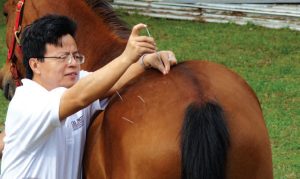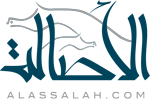By Allen Schoen
Veterinary acupuncture and acutherapy are considered valid modalities, but the potential for abuse exists. These techniques should be regarded as surgical and/or medical procedures under state veterinary practice acts. It is recommended that extensive continuing education programs be undertaken before a veterinarian is considered competent to practice acupuncture.
From the AAEP Guidelines on Therapeutic Options
INTRODUCTION
 There has been a great increase in interest in veterinary acupuncture in the equine industry recently, both by the public and the veterinary medical community. With this increased awareness, there has been an increase in research and thus a better understanding of the physiologic basis and practical applications of acupuncture. One of the main applications in equine practice is related to the treatment and diagnosis of lameness. Acupuncture may be used as both an adjunct (addition) to the traditional lameness examination as well as an adjunct to the treatment of certain lamenesses.
There has been a great increase in interest in veterinary acupuncture in the equine industry recently, both by the public and the veterinary medical community. With this increased awareness, there has been an increase in research and thus a better understanding of the physiologic basis and practical applications of acupuncture. One of the main applications in equine practice is related to the treatment and diagnosis of lameness. Acupuncture may be used as both an adjunct (addition) to the traditional lameness examination as well as an adjunct to the treatment of certain lamenesses.
SCIENTIFIC BASIS
Acupuncture may be defined as the stimulation of specific points on the body to achieve a therapeutic or homeostatic (returning the body to its normal state) effect. Acupuncture points are areas on the skin of decreased electrical resistance or increased electrical conductivity.
Acupuncture points correspond to four known neural structures:
-Type I acupoints, or motor points, are located where the nerve enters the muscle
-Type II acupoints are located on the superficial nerves
-Type III acupoints are found where there is a high density of superficial nerves
-Type IV acupoints are located at the muscle-tendon junction
Acupuncture has many physiologic effects on all systems throughout the body. No one mechanism can explain all the physiologic effects observed. Essentially, acupuncture stimulates various sensory receptors (pain, temperature, pressure and touch), which stimulate sensory nerves, transmitting the signal through the central nervous system to the brain. Various transmitters and hormones are then released from the brain to have their effects throughout the body.
TECHNIQUES
There are numerous techniques to stimulate acupuncture points, such as dry needle stimulation, electroacupuncture, aquapuncture, acupressure and others. Each method has its strengths and weaknesses. Deciding which acupuncture point to stimulate is based on locating points on the body where stimulation will produce a beneficial change in the central nervous system, altering on-going physiologic activity in the horse’s body. The number of treatments required depends upon the condition treated and how long the problem has existed. The length of individual treatments usually ranges from 5 to 30 minutes.
APPLICATIONS TO THE LAMENESS EXAMINATION
Acupuncture is an excellent diagnostic aid as an adjunct to conventional lameness examination. Acupuncture diagnosis is based on the level of sensitivity to palpation of particular acupuncture points (acupoints) that have been found to correspond with specific conditions. In addition, there are diagnostic points that are actually trigger points, knots or tight bands in a muscle. For example, a triceps trigger point is often quite sensitive to palpation when a lower forelimb lameness is present. It may not indicate exactly where the lameness is or what is causing it, but it does mean that something is reactive in that region.
Each diagnostic acupoint may have four or five meanings, depending on which other points show up as reactive upon examination. The combination of reactive points often times will assist the diagnosis and aid in localizing the cause of the problem. Sometimes acupoint diagnosis will help determine which of two or more problems may have come first, such as in the case of a lower limb lameness accompanied by a back problem. Patterns of trigger points far distant to the primary problem, compensating for the primary problem, have also been found.
Acupuncture diagnosis can be an excellent adjunct to the lameness examination in addition to flexion tests, diagnostic nerve blocks, radiographs (x-rays), ultrasound and fluoroscopy (x-rays in motion). It is not uncommon to use all of these diagnostic techniques, including nuclear scintigraphy (bone scanning), and still not arrive at a diagnosis. Acupuncture is often an excellent complementary technique that may assist in figuring out the problem.
APPLICATIONS TO LAMENESS TREATMENT
Acupuncture is also used successfully in the treatment of various equine lamenesses either as the primary treatment or as an adjunct to conventional veterinary treatment. For instance, a primary hock problem may be treated with an injection of medication directly into the joint. However, it may not completely resolve the entire complaint the owner has. The horse may still “not be right” or be “off.”
There often times is secondary compensation resulting in patterns of trigger points in the back or neck that remain unresolved. Acupuncture therapy may then be used quite successfully to treat the secondary problems of the primary hock problem. Acupuncture has been used successfully in the treatment of numerous equine lamenesses including chronic back problems, hock or stifle problems, laminitis, navicular disease and various soft tissue injuries. Acupuncture may also be beneficial in the treatment of non-lameness problems in the horse such as colic and diarrhea as well as reproductive, neurologic and respiratory conditions.
Acupuncture is an exciting new (yet ancient) diagnostic and therapeutic technique that has been incorporated into a number of equine practices. It offers an additional approach to diagnostic and therapeutic dilemmas that may not have adequate answers based on conventional western medicine. Further research will continue to explain the physiologic basis of acupuncture.



